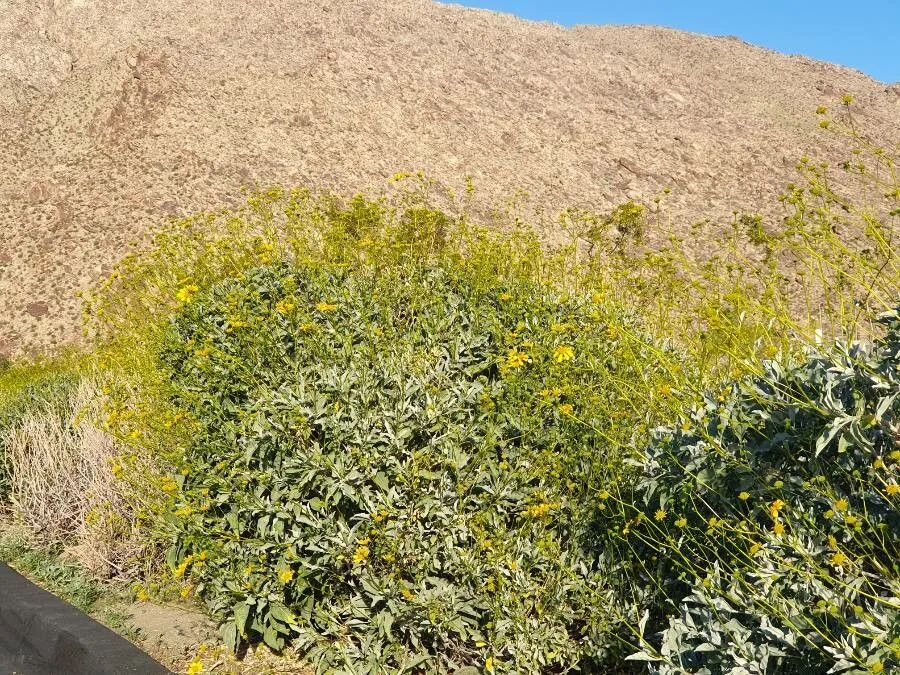
Author: A.Gray ex Torr.
Bibliography: : 143
Year: 1848
Status: accepted
Rank: species
Genus: Encelia
Vegetable: False
Observations: SW. U.S.A. to N. Mexico
Brittlebush, scientifically known as Encelia farinosa, is a remarkable plant native to the southwestern United States and northern Mexico. This resilient member of the Asteraceae family is well adapted to thrive in arid desert environments, showcasing both beauty and utility.
The plant’s common name, Brittlebush, aptly describes its nature. The stems of the plant are fragile and easily break under pressure, which is a dicernable characteristic contributing to its name. Encelia farinosa is distinguishable by its silvery-gray foliage that glistens under the desert sun, providing a striking contrast to the arid landscape. This coloration is due to the fine hairs that cover the leaves, reflecting sunlight and reducing water loss – a crucial adaptation for survival in such harsh climates.
During the blooming season, Brittlebush adorns the desert with vibrant yellow flowers. These daisy-like blooms not only add a splash of color to the surroundings but also play a significant role in the ecosystem. They attract a variety of pollinators, including bees and butterflies, thus contributing to the biodiversity of their habitat.
Historically, Encelia farinosa has been used by indigenous peoples for various purposes. The resin from the stems was traditionally used as an adhesive, while the plant was also employed in herbal remedies for its anti-inflammatory properties. Additionally, the dry, brittle stems were utilized as fuel, highlighting the plant’s versatility and importance to the native cultures.
The presence of Brittlebush across the southwestern United States to northern Mexico signifies its extensive adaptability and resilience. Its ecological role extends beyond beautifying the desert; it prevents soil erosion with its root system and provides shelter to small desert creatures.
In conclusion, Brittlebush, or Encelia farinosa, is a noteworthy desert plant of the Asteraceae family. Its distinct appearance, ecological benefits, and historical uses make it a valuable component of the desert landscape. This resilient plant not only withstands the challenging conditions of its habitat but also enriches the desert flora with its presence and contributes significantly to local ecosystems.
Eng: brittlebush, white brittlebush
Spa: incienso
En: Brittlebush, White brittlebush
Es: Incienso
© copyright of the Board of Trustees of the Royal Botanic Gardens, Kew.
© copyright of the Board of Trustees of the Royal Botanic Gardens, Kew.
© copyright of the Board of Trustees of the Royal Botanic Gardens, Kew.
Taken Jun 5, 2022 by Henry Broeska (cc-by-sa)
Taken May 10, 2022 by Binoya Joyry (cc-by-sa)
Taken Jan 15, 2022 by Shehadi Ramiz (cc-by-sa)
Taken Jan 15, 2022 by Shehadi Ramiz (cc-by-sa)
Taken Feb 21, 2022 by John L Green (cc-by-sa)
Taken Jun 1, 2018 by Daniel Barthelemy (cc-by-nc)
Taken May 9, 2021 by Manuel Hernández (cc-by-sa)
Taken Apr 8, 2022 by Henry Broeska (cc-by-sa)
Taken Mar 12, 2022 by Henry Broeska (cc-by-sa)
Taken Jan 15, 2022 by Shehadi Ramiz (cc-by-sa)
Taken Feb 21, 2022 by John L Green (cc-by-sa)
Taken Jun 1, 2018 by Daniel Barthelemy (cc-by-nc)
Taken Jun 1, 2018 by Daniel Barthelemy (cc-by-nc)
Taken Feb 21, 2022 by John L Green (cc-by-sa)
Taken May 9, 2021 by Manuel Hernández (cc-by-sa)
Growth form: Single Stem
Growth habit: Subshrub, Shrub
Growth rate: Rapid
Ph maximum: 8.5
Ph minimum: 7.0
Family: Myrtaceae Author: (F.Muell.) K.D.Hill & L.A.S.Johnson Bibliography: Telopea 6: 402 (1995) Year: 1995 Status:…
Family: Rubiaceae Author: Pierre ex A.Froehner Bibliography: Notizbl. Bot. Gart. Berlin-Dahlem 1: 237 (1897) Year:…
Family: Sapindaceae Author: Koidz. Bibliography: J. Coll. Sci. Imp. Univ. Tokyo 32(1): 38 (1911) Year:…
Family: Asteraceae Author: A.Gray Bibliography: Pacif. Railr. Rep.: 107 (1857) Year: 1857 Status: accepted Rank:…
Family: Fabaceae Author: Medik. Bibliography: Vorles. Churpfälz. Phys.-Ökon. Ges. 2: 398 (1787) Year: 1787 Status:…
Family: Aspleniaceae Author: (Cav.) Alston Bibliography: Bull. Misc. Inform. Kew 1932: 309 (1932) Year: 1932…